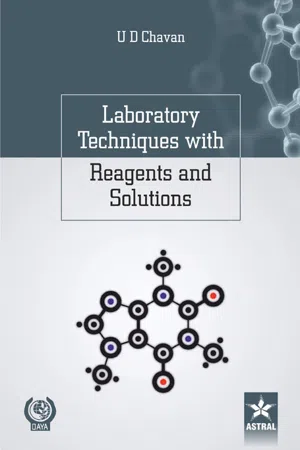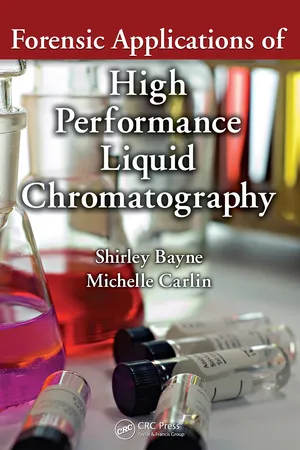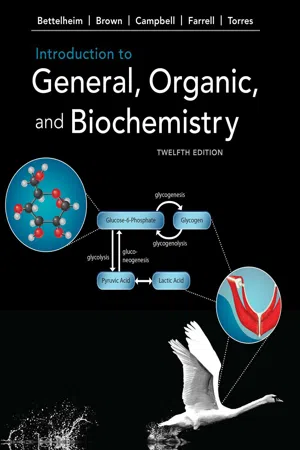Chemistry
Buffers Preparation
Buffers preparation involves creating a solution that resists changes in pH when an acid or base is added. This is typically achieved by mixing a weak acid and its conjugate base, or a weak base and its conjugate acid, in specific proportions. The resulting buffer solution is important in various chemical and biological processes, as it helps maintain a stable pH environment.
Written by Perlego with AI-assistance
Related key terms
1 of 5
10 Key excerpts on "Buffers Preparation"
- Chavan, U D(Authors)
- 2021(Publication Date)
- Daya Publishing House(Publisher)
DEFINITION/PRINCIPLES AND ABBREVIATIONS USED The function of pH buffers is to neutralize small changes in H + and OH - concentrations, thereby maintaining pH fairly constant. The basics of pH buffering and buffer calculations and preparation are discussed below. The necessary symbols and their meanings are as follows: A weak acid and its conjugate base are represented by HA and A -, respectively; a weak base and its conjugate acid are represented by R-NH 2 and R-NH, respectively, because the most commonly used weak base buffers has NH 2 basic functional group(s). In aqueous solutions, H + is hydrated and, therefore, is written as Hp+ when necessary. Molar concentration is indicated by enclosing the substance of interest in square brackets; for example, [H + ] represents the molar concentration of H + . Buffer a solution that resists pH change is an important for many reactions e.g., enzymatic methods of analysis, etc. Buffer solutions are solutions that resist changes in pH (by resisting changes in hydronium ion and hydroxideion concentrations) upon addition of small amounts of acid or base, or upon dilution. They usually consist of a weak acid and its conjugate base, or, less commonly, a weak base and its conjugate acid. Buffer solutions are used in industry for chemical manufacturing and fermentation processes, and to set the proper conditions for dyeing fabrics. In research laboratories, buffers are used for chemical analyses, syntheses, and calibration of pH meters. In living organisms, these solutions maintain the correct pH for many enzymes to work. Blood plasma contains a buffer (of carbonic acid and bicarbonate) to maintain a pH of approximately 7.4. The main component of a buffer solution, such as a weak acid or weak base, may be used as a buffering agent. The function of a buffering agent is to drive an acidic or alkaline solution to a certain pH and maintain it at that pH.- eBook - PDF
- Krish Moorthy(Author)
- 2007(Publication Date)
- CRC Press(Publisher)
Fundamentals of Biochemical Calculations 56 Buffers A buffer solution is one that resists a change in pH on the addition of an acid or alkali. Buffers are solutions of a weak acid and one of its salts (the conjugate base) or a weak base and one of its salts (a conjugate acid). The most useful equation for dealing with quantitative aspects of buffers is the Henderson-Hasselbalch equation: pH = pK a + log 10 [A ] [HA] -All the terms in this equation have been previously described. The [ ] strictly mean molar concen-trations, but as a ratio is involved, any chemical concentration unit will do. Students must gain a good feel for the whole equation as well as the individual terms; it can be quite tricky because ratios and negative logs are involved and also because chemical terms, such as base and salt, could mean the same thing. Please check the following: pH is the variable term, the pH of the required buffer. pK a is fixed once the buffer system is chosen (e.g., for acetate buffer, pK a = 4.76). [A ] [HA] -= [salt] [acid] = [base] [acid] = [non -protonated] [protonated] The last expression is particularly descriptive when several protonated or deprotonated groups are involved, such as with amino acid structures. The ratio [A ] [HA] -or [salt] [acid] is the most important term in the Henderson-Hasselbalch equation. It is this term that determines the pH of the buffer. It is this term that students should carefully evaluate in buffer calculations and preparations. For a start, note that log of 1 = 0, log of a number > 1 is positive, and log of a number < 1 is negative. It therefore follows that: when [salt] = [acid], pH = pK (with the acetate buffer system, the pH of the buffer would be 4.76) when [acid] > [salt], pH < pK (acetate buffer, pH would be < 4.76) when [acid] < [salt], pH > pK (acetate buffer, pH would be > 4.76). The simple rule of thumb is: the greater the [acid], the lower the pH of the buffer. - eBook - PDF
- Ali D. Hames(Author)
- 2014(Publication Date)
- Academic Press(Publisher)
CHAPTER 1 BUFFERS, CHELATING AGENTS AND DENATURANTS J. A. A. Chambers 1. BUFFERS 1.1. Introduction Buffers maintain pH within a limited range (Figures 1 and 2) despite the generation or loss of hydrogen ions by the reactions going on within the system. Buffers are weak acids or bases that are not fully dissociated in solution. Within a Umited pH range the equiUbrium between the dissociated and undissociated forms of the buffer remains constant. Many such substances have been used but comparatively few remain widely used. Some unusual buffers remain in use for specific systems. Table 1 summarizes the properties of non-zwitterionic buffers. 1.2. Goods'buffers Goods' buffers (1) are a group of zwitterionic organic compounds, primarily sulfonates and tertiary amines, that show excellent buffering properties, solubihty and biological and chemical inertness. As a group these buffers show excellent compatibility with biological systems. The properties of these are sunmiarized in Table 2. 1.3. Preparation of buffers Buffers are prepared by two methods: (i) bringing a dissolved solution of the buffer to the correct pH by titrating with a strong acid or base; or (ii) mixing of stock solutions; this is used frequently for phosphate and acetate buffers. When the mixing of stock solutions is used confusion can sometimes arise over what the molarity refers to. In the case of phosphate and acetate buffers the molarity refers to all phosphate or acetate ions in the medium (see Sections 1.8 and 1.9 for the preparation of these buffers). On the other hand, for most buffers the concentration refers to the buffer substance alone and the concentration of the titrating acid or base is ignored. Tables 3 and 4 give the composition of phosphate and acetate buffers, respectively. 1.4. Counter ions Buffers with an acid pXg are brought to their working pH with a strong base (e.g. NaOH, KOH), and those with a basic pA^^ use a strong acid (e.g. HCl). - eBook - ePub
- Professor Rob Beynon, J Easterby(Authors)
- 2004(Publication Date)
- Taylor & Francis(Publisher)
5 Preparation of buffer solutions• Using written recipes• Design of new buffers• Practical considerations• Describing buffers1. Where do I start?Armed with a new understanding of buffer theory, you will, sooner or later, need to prepare a buffer for pH control. But how do you decide which buffer to prepare? Often, you will be able to follow specifications as presented to you in a laboratory manual or scientific paper. Beware— sometimes these recipes are incomplete or misleading. You will need your newly won capability to interpret these incomplete recipes, just as much as if you had to make the buffer from first principles. There will be times when you will need to design your buffer system from scratch. For example, you may need to design a new buffer for a chromatographic separation, determine the pH optimum of a system, or assess buffer-specific effects in a new procedure. In this chapter, we will discuss the practicalities of buffer preparation, and show how the rather abstract theory of the previous chapter really does influence ‘wet’ laboratory procedures.2. Following existing recipesIn scientific papers or published protocols, you will read descriptions of buffers. In most instances, the description will (we hope) be complete and precise, and you will have no difficulties in making up such a buffer. Be forewarned, however, that there is usually more than one procedure that you can follow to make a buffer and you may have to choose the one that yields the same buffer as the original authors intended.◊ This can require skills in mindreading in some cases!Sometimes the published description will be vague. The scientific literature, and other people’s notebooks are littered with ‘shorthand’ descriptions such as ‘0.1 M acetate, pH 5.0’, ‘0.05M Tris/acetate’, or, even worse, ‘2X Buffer A’—you will probably succeed in part if you attempt to prepare the first example, have difficulty with the second, and should not even attempt the last of these! - eBook - PDF
Molecular Biology Problem Solver
A Laboratory Guide
- Alan S. Gerstein(Author)
- 2004(Publication Date)
- Wiley-Liss(Publisher)
. . . . . . . . . . . . . . . . . . . 44 What Organics Can Be Present in the Water? . . . . . . . . . . . 45 What Other Problems Occur in Water Systems? . . . . . . . . . 46 Bibliography . . . . . . . . . . . . . . . . . . . . . . . . . . . . . . . . . . . . . . . . . . . 47 BUFFERS Why Buffer? The primary purpose of a buffer is to control the pH of the solu- tion. Buffers can also play secondary roles in a system, such as controlling ionic strength or solvating species, perhaps even affect- ing protein or nucleic acid structure or activity. Buffers are used to stabilize nucleic acids, nucleic acid–protein complexes, proteins, and biochemical reactions (whose products might be used in subsequent biochemical reactions). Complex buffer systems are used in electrophoretic systems to control pH or establish pH gradients. Can You Substitute One Buffer for Another? It is rarely a good idea to change the buffer type—that is, an amine-type buffer (e.g., Tris) for an acid-type buffer (e.g., phos- phate). Generally, this invites complications due to secondary effects of the buffer on the biomolecules in the system. If the purpose of the buffer is simply pH control, there is more latitude to substitute one buffer for another than if the buffer plays other important roles in the assay. How Does a Buffer Control the pH of a Solution? Buffers are solutions that contain mixtures of weak acids and bases that make them relatively resistant to pH change. Concep- tually buffers provide a ready source of both acid and base to either provide additional H + if a reaction (process) consumes H + , or combine with excess H + if a reaction generates acid. 32 Pfannkoch The most common types of buffers are mixtures of weak acids and salts of their conjugate bases, for example, acetic acid/sodium acetate. In this system the dissociation of acetic acid can be written as CH 3 COOH Æ CH 3 COO - + H + where the acid dissociation constant is defined as K a = [H + ] [CH 3 COO - ]/[H 3 COOH]. - Shirley Bayne, Michelle Carlin(Authors)
- 2017(Publication Date)
- CRC Press(Publisher)
Buffer Preparation Small changes in mobile phase pH can have a pronounced effect on the sepa-ration of acidic and basic compounds. It is necessary, therefore, to ensure that a consistent and reproducible approach is taken when preparing mobile phase buffers. A common approach is to measure an amount of water, equivalent to approximately half the final volume, into a suitably sized beaker. The buf-fer salt should be accurately weighed in a weighing boat and quantitatively transferred to the beaker with the aid of small quantities of water. The pH of the solution should be measured and adjusted, if necessary, at this time. The solution should then be quantitatively transferred into a suitable volumetric flask and made to volume with water. The solution should be inverted several times to ensure thorough mixing. The organic portion of the mobile phase should be dispensed and added to the buffer solution in a suitable HPLC vessel to produce the final mobile phase. This phase should be thoroughly mixed, filtered, and degassed prior to use. A: pH 7; not buffered A: pH 7; buffered A: pH 3; buffered Retention Time Retention Time Retention Time Column: C18, Mobile Phase: Methanol/Water, Flow Rate: 1 ml/min, Detection: UV@254 nm Figure 3.6 Effect of pH on the separation of two acidic compounds. 58 Forensic Applications of High Performance Liquid Chromatography Sample and Standard Preparation The extent to which a sample has to be prepared for analysis will be depen-dent on the nature of the sample that is presented for analysis. For example, a single bag of white powder will require minimal preparation and can be sampled, diluted in an appropriate solvent, mixed, filtered, and dispensed into an HPLC vial ready for analysis. However, not all forensic samples are quite so simple and, even when they might appear simple, some sample pre-treatment will be required in order to ensure homogeneity.- Frank R. Foulkes(Author)
- 2012(Publication Date)
- CRC Press(Publisher)
CHAPTE R TWENTY-TW O BUFFER SOLUTIONS 22.1 BUFFER SOLUTIONS In our ionic equilibrium calculations thus far, we have been solving for pH at equilibrium. The rea-son pH is so important is that a great number of chemical and biochemical processes only operate satisfactorily if the pH is held within certain narrow limits. For example, to name just a few, the pH of the medium affects the characteristics of electroplated deposits; the reactivity of enzymes; the rate of metallic corrosion; the permeability of cell membranes; the efficiency of fermentations to produce beer, wine, and alcohol; the precipitation of various substances; and the growth of micro-organisms and plants. In fact, the human body itself is full of controlled pH processes: The pH of the blood should be held between 7.30 and 7.45; if your blood pH falls below 6.8 or rises above 7.8 your body enters a state known as––“death.” The pH of blood plasma should be maintained between 7.38 and 7.41; the pH of saliva usually is about 6.8; the pH within the duodenum must be held between 6.0 and 6.5; for proper digestion the pH of the gastric juices within the stomach must be kept between 1.6 and 1.8. The body maintains these various pH ranges, as needed, by means of chemical constitu-ents that resist pH change when small amounts of acid or base are added. Solutions with such regulatory pH power are called buffer solutions . Buffer solutions contain relatively large amounts of either (a) a weak acid and its salt––this kind of buffer stabilizes pH < 7, or (b) a weak base and its salt––this kind of buffer stabilizes pH > 7.- Frederick Bettelheim, William Brown, Mary Campbell, Shawn Farrell(Authors)
- 2019(Publication Date)
- Cengage Learning EMEA(Publisher)
● These buffers have qualities useful to scientists, such as not crossing membranes and resisting pH change with dilution or temperature change. ● You do not have to understand the structure of these buf-fers to use them. The important things to know are the molar mass and the p K a of the weak acid form of the buffer. ● Solutions with pH less than 7 are acidic; those with pH greater than 7 are basic. A neutral solution has a pH of 7. ● The pH of an aqueous solution is measured with an acid–base indicator or with a pH meter. 8.9 Using Titrations to Calculate Concentration ● We can measure the concentration of aqueous solutions of acids and bases using titration. In an acid–base titra-tion, a base of known concentration is added to an acid of unknown concentration (or vice versa) until an equi-valence point is reached, at which point the acid or base being titrated is completely neutralized. 8.10 Buffers ● A buffer does not significantly change its pH when small amounts of either hydronium ions or hydroxide ions are added to it. ● Buffer solutions consist of approximately equal concen-trations of a weak acid and its conjugate base. ● The buffer capacity depends on both its pH relative to its p K a and its concentration. The most effective buffer solutions have a pH equal to the p K a of the weak PROBLEMS Problems marked with a green caret are applied. 8.1 Acids and Bases 1 Define (a) an Arrhenius acid and (b) an Arrhenius base. 2 Write an equation for the reaction that takes place when each acid is added to water. (a) HNO 3 (b) HBr (c) HCO 3 2 (d) NH 4 1 3 Write an equation for the reaction that takes place when each base is added to water. (a) LiOH (b) (CH 3 ) 2 NH (c) Sr(OH) 2 (d) CH 3 CH 2 NH 2 8.2 Defining the Strength of Acids and Bases 4 For each of the following, tell whether the acid is strong or weak. (a) Acetic acid (b) HCl (c) H 3 PO 4 (d) H 2 SO 4 (e) HCN (f) H 2 CO 3 5 For each of the following, tell whether the base is strong or weak.- eBook - PDF
- F. John Gennari, Horacio J. Adrogue, John H. Galla, Nicolaos Maddias, F. John Gennari, Horacio J. Adrogue, John H. Galla, Nicolaos Maddias(Authors)
- 2005(Publication Date)
- CRC Press(Publisher)
With continued addition of either a strong acid or base to a solu-tion, the corresponding weak acid or base eventually becomes saturated. In the example above, this happens when all available base (HPO 4 2 ) combines with the added H þ to form the acid, H 2 PO 4 . When this occurs, all further added H þ will remain in solution, rapidly lowering the pH until H 2 PO 4 becomes a proton acceptor (pH < 3.0). This behavior leads to the typical sigmoid titration curves in Fig. 2. Quantitation of Buffer Effect on Acidity Figure 2 depicts the titration curves of three buffers: acetic acid = acetate, uric acid = monourate, and monobasic phosphate = dibasic phosphate. The mid-point of each of the curves denotes the setting in which the concentrations of the acid and its conjugate base are equal. From Eqs. (9) and (10), one can see that when these concentrations are equal, [H þ ] ¼ K 0 or pH ¼ p K 0 . As illustrated in Fig. 2, the buffering ability or capacity is also the greatest when pH ¼ p K 0 . Acid–Base Chemistry and Buffering 7 The capacity of a specific buffer to resist a change in pH is defined as its buffer value ( b ), the first derivative of the titration curve: b ¼ d ð acid or base Þ = dpH ð 14 Þ Buffer value is conventionally expressed as mol = L or mmol = L of strong acid or base added per unit change in pH. Given the curves in Figure 2, it is apparent that b varies with pH and reaches a maximum when pH ¼ p K 0 . This unit of measure has been named the slyke, in honor of Donald D. Van Slyke (15), a pioneer in the study of acids and bases in biological fluids. In a seminal paper, he deduced that b is a function of the concentration of the weak acid in a solution (C), the K 0 (or p K 0 ) of the buffer, and the prevail-ing [H þ ] (16). He also showed that for any weak acid, the maximal value for b (i.e., when [H þ ] ¼ K 0 or pH ¼ p K 0 ) is 0.575. - eBook - PDF
- Charlotte W. Pratt, Kathleen Cornely(Authors)
- 2020(Publication Date)
- Wiley(Publisher)
The broad, flat shape of the titration curve shown in Figure 2.16 indicates that the pH does not change drastically with added acid or base when the pH is near the pK. The effective buffering capacity of an acid is generally taken to be within one pH unit of its pK. For acetic acid (pK = 4.76), this would be pH 3.76–5.76. Biochemists nearly always perform experiments in buffered solutions in order to maintain a constant pH when acidic or basic substances are added or when chemical reactions produce or consume protons. Without buffering, fluctuations in pH would alter the ionization state of the molecules under study, which might then behave differently. Before biochemists appreci- ated the importance of pH, experimental results were often poorly reproducible, even within the same laboratory. A buffer solution is typically prepared from a weak acid and the salt of its conjugate base (see Sample Calculation 2.5). The two are mixed together in the appropriate ratio, according to the Henderson–Hasselbalch equation, and the final pH is adjusted if necessary by adding a small amount of concentrated HCl or NaOH. In addition to choosing a buffering compound with a pK value near the desired pH, a biochemist must consider other factors, including the compound’s solubility, stability, toxicity to cells, reactivity with other molecules, and cost. pH pK 0 0.5 H + ions dissociated 1 [CH 3 COOH] > [CH 3 COO − ] [CH 3 COOH] < [CH 3 COO − ] Midpoint [CH 3 COOH] = [CH 3 COO − ] Start point End point 1 2 3 4 5 6 7 8 Effective buffering range SAMPLE CALCULATION 2.5 PROBLEM How many mL of a 2.0-M solution of boric acid must be added to 600 mL of a solution of 10 mM sodium borate in order for the pH to be 9.45? FIGURE 2.16 Titration of acetic acid. At the start point (before base is added), the acid is present mainly in its CH 3 COOH form. As small amounts of base are added, protons dissociate until, at the midpoint of the titration (where pH = pK), [CH 3 COOH] = [CH 3 COO − ].
Index pages curate the most relevant extracts from our library of academic textbooks. They’ve been created using an in-house natural language model (NLM), each adding context and meaning to key research topics.









